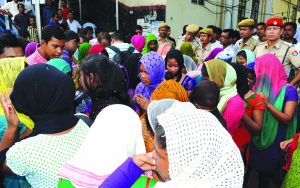 Girls in thousands go missing from their homes in West Bengal every year. Of the 8,137 cases of human trafficking reported in the country in 2016, according to the NCRB, a total of 3,579 cases were from West Bengal. While existing measures to prevent trafficking are failing to contain incidences of the crime, the law enforcement system has borne down hard on the illegal sex trade; the number of raids in red light districts to rescue victims of trafficking has gone up in recent years. Consequently, there have been more trafficker arrests — 1,847 in West Bengal in 2016 — although rates of conviction remain abysmally low.
Girls in thousands go missing from their homes in West Bengal every year. Of the 8,137 cases of human trafficking reported in the country in 2016, according to the NCRB, a total of 3,579 cases were from West Bengal. While existing measures to prevent trafficking are failing to contain incidences of the crime, the law enforcement system has borne down hard on the illegal sex trade; the number of raids in red light districts to rescue victims of trafficking has gone up in recent years. Consequently, there have been more trafficker arrests — 1,847 in West Bengal in 2016 — although rates of conviction remain abysmally low.
As more rescues happen, survivors of trafficking enter the early phases of their rehabilitation journey, into shelter homes. This is a critical time, when the survivor’s trauma is at its peak and vulnerabilities are freshest. She needs help, and the authorities take this need seriously. They take her “into custody” and take over her means to be the agent of her own destiny. Shelter home environments are often charged with misogynist rhetoric and abuse, with sex trafficking victims bearing the brunt of the worst bullying — until their families can be traced and their repatriation arrangements made.
In a letter to the NCPCR, Utthan, a sex trafficking survivors council from West Bengal highlighted this state of affairs, saying, “even if one needs to be in the shelter home for any length of time, the question that disturbs us is — are these shelter homes really doing what they are supposed to do, in terms of protection and rehabilitation? When a woman or a girl child is placed in the shelter home, she expects it to provide her safety and security unlike the place from where she has come or rescued. On the contrary, our states are funding homes which are nothing less than brothels…”
The custodial model of rehabilitation that an overwhelming majority of stakeholders in the sex trafficking survivor’s recovery plan adopts insidiously strips the survivor of any role in outlining her own rehabilitation plan. Doctors, police, social workers, civil servants, lawmakers, and politicians consult each other (but not her) to decide what is best for her and makes her rehabilitation decisions on her behalf. For decades, this has involved post- repatriation healthcare and vocational training.
The medical facility the survivor receives near her home is often sketchily administered; many go without any assessment of their mental health status. Despite receiving training, survivors have been known to remain trapped in poverty, some return to sex work, or get trapped again in bonded labor arrangements. “Responsibility of shelter homes is not just to give them vocational trainings which are of no use to them once they are out. Focus should also be on building their capacity…,” Utthan goes on to say in the same letter.
It becomes apparent, then, that rehabilitation efforts without a formulated reintegration goal comes with a possibility of frustration, and when we discuss reintegration-focused strategies to help survivors embrace mainstream social living we must consider sustainable, inclusive solutions designed to empower rather than foster a class of women whose enormous resilience and potential to reclaim their lives are allowed to be thwarted for lack of opportunity. Community-based rehabilitation models, distinct in character from custodial ones, are outlined around principles that enable survivors (in this context, of sex trafficking) with knowledge of their rights and the public services they are entitled to, and how these can help them rebuild their lives from scratch after repatriation in their native communities.
A survivor emerges confident and autonomous when she has been adequately trained on her rights and their implications, able to have conversations assertively with dutybearers involved in the larger scheme of her rehabilitation. Zulikha (not her real name), a North 24 Parganas survivor, says, “I feel more confident now. I am not afraid to go and meet any dutybearers and I will write all the applications in Bengali and deliver them on time.” Piya (name changed), another survivor, reports, “Previously I did not want to approach any work. I was ashamed and afraid to fail. But now I know it always takes initiative to begin something.”
Also, community-based rehabilitation (CBR) plans introduce elements of restorative care to develop individual rehabilitation plans for each survivor based on her personal narrative and struggles and her needs and wants, in keeping with her vision of autonomy, of having her own voice. Each story of having triumphed abuse, violence and deprivation is central to the survivor’s sense of self, and as she receives restorative care, this self-image and ways to boost it get the respect and attention they deserve.
Restorative care is also coupled with a trauma-informed method of responding to the survivors’ needs; this means that caregivers involved in the rehabilitation process acknowledge that she has been through (perhaps irreversible and unforgettable) trauma and this has molded her personhood in strong, enduring ways. They answer to the experience of such deep trauma with empathy, with the objective of making the survivor feel physically and emotionally safe. “It is unfortunate that our current rehabilitation systems are based on a way of offering mental healthcare to survivors of trafficking that is convenient at best and lazy at worst,” says psychologist Chandrani Dasgupta. “We need to put much greater emphasis on the depression, anxiety, and anger that a trauma victim has to live with, and factor in the distress she experiences due to sexual and body-image concerns, when we think about her care plans.”
Community-based rehabilitation plans, in short, map rehabilitation and reintegration journeys with survivors, and not for them. The agency for every process that makes up the whole rehabilitation scheme for each woman remains with her, and not with a social worker, counselor, lawyer, or administrative official. Each of the participants in community-based rehabilitation is sensitized to the survivor’s needs and agendas as the plan shapes up. Social worker Soma Sarkar says, “It really worked. When we approached the dutybearer with the rightholder (the survivor) the applications became that much more credible. Dutybearers started really feeling their responsibilities, they behaved sympathetically and sensitively, often they didn’t need us, they just talked directly with the survivor.”
Although the ideal community-based rehabilitation scheme is participatory and democratic, with every player in it performing their roles adequately and punctually, the survivor comes first; her needs are subject to change as her primary entitlements (citizenship papers, food security, housing) are secured and long-term psychosocial interventions are made to her case, and room must be left for improvisations to be made to case management plans over time. There is the risk that administrative red tape imposes obstacles in the way of the survivor getting the services she needs, or of an official occasionally behaving insensitively and stigmatizing the woman and her story, but these risks are minimized as the model itself is refined and put in practice in larger spaces.
Roop Sen, secretary and technical advisor at Sanjog, a Kolkata-based technical resource organization that has developed a community-based rehabilitation model, says,” In the absence of a state backed community based rehabilitation policy, Panchayats, block and district administrators are restricted in their service delivery to survivors – there are no clear directives to set priorities and targets. The biggest challenge in community based rehabilitation is when it is not backed by policy and programmes.
The CBR model in Bengal can be sustainable once it is backed by policy, when the State recognises that the focus of rehabilitation needs to be based in community based rehabilitation models instead of in shelter homes.” Sen endorses heavy duty central and local scheme design (based on the Ujjwala and MuktirAlo blueprints) to reinforce CBR implementation, which lets social workers assist survivors better with accessing their entitlements. These models of rehabilitation for sex trafficking survivors in India are not widely popular yet, despite their incontestable benefits over custodial models in practice everywhere. But Partners in Anti-Trafficking and Bansra Birangana Seva Samity work in the North and South 24 Parganas of West Bengal on a project called Shakti founded on community-based rehabilitation concepts, with 130 survivors in the region.
The Shakti prototype is the brainchild of technical resource think tank Sanjog, which has invested in the program’s resource mobilisation, training needs, capacity building activities, and offered it leadership and communications facilitation support since 2016. Sanjog has also offered policymaking support to community based organisations and state government bodies. Uma Chatterjee, Sanjog’s executive director said,”Shakti can be one of the exemplary models of rehabilitation and prevention under the new anti trafficking Bill. Financiers and governments need to financially back such community based models in partnership with survivors to finally see an end to this menace.”
letters@tehelka.com













